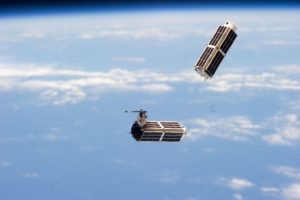
With demand for Earth imagery increasing, manufacturers are expected to produce some 1,935 remote sensing satellites over the next 10 years, according to Forecast International.
The company’s new study, “The Market for Civil & Commercial Remote Sensing Satellites,” reports that during the 2016-2025 forecast period, the value of production will be an estimated $29 billion (in FY16 U.S. dollars). The study covers 58 satellite production programs.
Satellite operators will purchase new satellites over the next 10 years to keep up with rising demand for remote sensing imagery. The analysis reflects the increasing importance of small satellite operators, as their plans to operate constellations of dozens or even hundreds of satellites will affect production rates going forward.
The average launch mass of remote sensing satellites increased from 851 kilograms in 2011 to 1,775 kilograms in 2013. However, William Ostrove, the study’s author, notes that “2014 saw a substantial decline in average launch mass. The increasing numbers of small satellites dropped average launch mass down to 301.8 kilograms. The decline continued in 2015, dropping to 226.1 kilograms.”
This is not to say that there has been a lack of opportunities for large satellites. Ostrove points out that Russia’s Resurs-P3, which launched in March 2016, weighed 5,920 kilograms at launch. The decline in average launch mass is due to an increased number of small satellites, not a decreased number of large satellites.
Another major trend in the remote sensing satellite market is growing commercialization. Historically, governments have bought the lion’s share of remote sensing satellites. While both civil and military government agencies will remain important players in the market, both as operators of satellites and buyers of imagery, the commercial market is becoming more important. Between 2011 and 2015, Ostrove says that “159 commercial satellites were launched and 74 civil government satellites were orbited. Commercial satellites have increased in importance as commercial companies have readily adopted the small satellite form.”
Remote sensing satellites have a wide variety of uses that will drive demand. These uses include civil planning, weather forecasting, climate change observation, and military reconnaissance. Newer commercial uses include oil and gas exploration, damage estimation for insurance claims, property and real estate appraisals, building site selection and development, and utility and communications infrastructure planning.
The top manufacturers in the civil and commercial remote sensing satellite industry going forward will be Airbus Defence and Space, Thales Alenia Space, Mitsubishi Electric, Lavochkin, and Lockheed Martin. Ball Aerospace was included on the list last year but fell off because Orbital ATK was awarded a contract to build three Joint Polar Satellite System (JPSS) spacecraft that Ball was originally expected to build. The top-five companies are forecast to garner a combined $15 billion in sales building remote sensing satellites over the next 10 years, accounting for a market share of 52 percent.
Original published at: http://spacewatchme.com/2016/07/smallsats-play-growing-role-29-billion-remote-sensing-satellite-market/
 SpaceWatch.Global An independent perspective on space
SpaceWatch.Global An independent perspective on space

